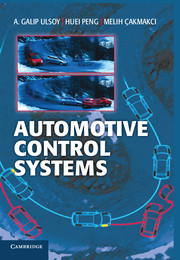Book contents
- Frontmatter
- Contents
- Preface
- Part I Introduction and Background
- Part II Powertrain Control Systems
- Part III Vehicle Control Systems
- Part IV Intelligent Transportation Systems
- 17 Overview of Intelligent Transportation Systems
- 18 Preventing Collisions
- 19 Longitudinal Motion Control and Platoons
- 20 Automated Steering and Lateral Control
- Appendices
- Index
- References
20 - Automated Steering and Lateral Control
Published online by Cambridge University Press: 05 June 2012
- Frontmatter
- Contents
- Preface
- Part I Introduction and Background
- Part II Powertrain Control Systems
- Part III Vehicle Control Systems
- Part IV Intelligent Transportation Systems
- 17 Overview of Intelligent Transportation Systems
- 18 Preventing Collisions
- 19 Longitudinal Motion Control and Platoons
- 20 Automated Steering and Lateral Control
- Appendices
- Index
- References
Summary
This chapter focuses on AVCS for ITS, which are concerned with vehicle lateral motion control. The first part of the discussion is about a potential AVCS-II or AVCS-III technology for lane sensing and lane tracking in a lane-departure warning system. It is an intermediate step to fully automated steering, which is a potential AVCS-III technology.
Lane Sensing
To automate the lateral control of vehicles, it is necessary to measure the position of a vehicle in the lane. Various schemes have been proposed and tested for this purpose, including the use of (1) an on-board vision system that detects the painted lane markings on a highway; (2) continuous magnetic wires imbedded in the center of the lane; (3) radar or ultrasonic waves to measure the distance to sidewalls; (4) a forward-looking laser to detect reflective markers; and (5) discrete magnetic markers imbedded in the roadway. Clearly, the onboard vision systems are more difficult to develop but offer the potential capability of autonomous operation. The latter four schemes require the necessary highway infrastructure to be in place. These cooperative systems, however, are likely to provide more accurate lane-position information at higher speeds with simpler and more inexpensive devices in a vehicle. Magnetic wires and markers also are more reliable under adverse weather conditions (e.g., fog, rain, and snow). Prototype systems based on the other sensing schemes (i.e., vision, laser, and radar) have not been shown to work in inclement weather. Recently, GPS-based systems have been proposed for lateral and longitudinal positioning; however, the accuracy is still not good enough, even when differential GPS is used. Furthermore, GPS may not be available in all areas (e.g., urban canyons); therefore, systems based on GPS measurement and road maps are still under development.
- Type
- Chapter
- Information
- Automotive Control Systems , pp. 348 - 360Publisher: Cambridge University PressPrint publication year: 2012

